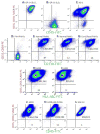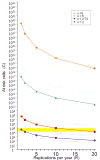The rate of spontaneous mutations in human myeloid cells
- PMID: 23748046
- PMCID: PMC4524336
- DOI: 10.1016/j.mrfmmm.2013.05.004
The rate of spontaneous mutations in human myeloid cells
Abstract
The mutation rate (μ) is likely to be a key parameter in leukemogenesis, but historically, it has been difficult to measure in humans. The PIG-A gene has some advantages for the detection of spontaneous mutations because it is X-linked, and therefore only one mutation is required to disrupt its function. Furthermore, the PIG-A-null phenotype is readily detected by flow cytometry. Using PIG-A, we have now provided the first in vitro measurement of μ in myeloid cells, using cultures of CD34+ cells that are transduced with either the AML-ETO or the MLL-AF9 fusion genes and expanded with cytokines. For the AML-ETO cultures, the median μ value was ∼9.4×10(-7) (range ∼3.6-23×10(-7)) per cell division. In contrast, few spontaneous mutations were observed in the MLL-AF9 cultures. Knockdown of p53 or introduction of mutant NRAS or FLT3 alleles did not have much of an effect on μ. Based on these data, we provide a model to predict whether hypermutability must occur in the process of leukemogenesis.
Keywords: AML; B-lymphoblastoid cell lines; BLCLs; GPI; GPI-linked proteins; Human myeloid cultures; Mutation rate; Myeloid leukemia.; PIG-A gene; PNH; Spontaneous somatic mutations; acute myelogenous leukemia; glycosylphosphatidylinositol; paroxysmal nocturnal hemoglobinuria.
Copyright © 2013 Elsevier B.V. All rights reserved.
Conflict of interest statement
Conflicts of interest: The authors have no relevant conflicts of interest to disclose
Figures


Similar articles
-
Transcription factor RUNX1 promotes survival of acute myeloid leukemia cells.J Clin Invest. 2013 Sep;123(9):3876-88. doi: 10.1172/JCI68557. Epub 2013 Aug 27. J Clin Invest. 2013. PMID: 23979164 Free PMC article.
-
Relationships between AML1-ETO and MLL-AF9 fusion gene expressions and hematological parameters in acute myeloid leukemia.Gulf J Oncolog. 2020 Sep;1(34):65-69. Gulf J Oncolog. 2020. PMID: 33431365
-
Distinct classes of c-Kit-activating mutations differ in their ability to promote RUNX1-ETO-associated acute myeloid leukemia.Blood. 2012 Feb 9;119(6):1522-31. doi: 10.1182/blood-2011-02-338228. Epub 2011 Sep 21. Blood. 2012. PMID: 21937700 Free PMC article.
-
The use of PIG-A as a sentinel gene for the study of the somatic mutation rate and of mutagenic agents in vivo.Mutat Res. 2010 Jul-Sep;705(1):3-10. doi: 10.1016/j.mrrev.2009.12.004. Epub 2009 Dec 24. Mutat Res. 2010. PMID: 20034593 Review.
-
Proleukemic RUNX1 and CBFbeta mutations in the pathogenesis of acute leukemia.Cancer Treat Res. 2010;145:127-47. doi: 10.1007/978-0-387-69259-3_8. Cancer Treat Res. 2010. PMID: 20306249 Review.
Cited by
-
Glycosylphosphatidylinositol (GPI) anchored protein deficiency serves as a reliable reporter of Pig-a gene Mutation: Support from an in vitro assay based on L5178Y/Tk+/- cells and the CD90.2 antigen.Environ Mol Mutagen. 2018 Jan;59(1):18-29. doi: 10.1002/em.22154. Epub 2017 Nov 8. Environ Mol Mutagen. 2018. PMID: 29115020 Free PMC article.
-
Towards Quantitative Systems Pharmacology Models of Chemotherapy-Induced Neutropenia.CPT Pharmacometrics Syst Pharmacol. 2017 May;6(5):293-304. doi: 10.1002/psp4.12191. Epub 2017 Apr 18. CPT Pharmacometrics Syst Pharmacol. 2017. PMID: 28418603 Free PMC article. Review.
-
Somatic Mutations and Autoimmunity.Cells. 2021 Aug 11;10(8):2056. doi: 10.3390/cells10082056. Cells. 2021. PMID: 34440825 Free PMC article. Review.
-
Somatic mutations in clonally expanded cytotoxic T lymphocytes in patients with newly diagnosed rheumatoid arthritis.Nat Commun. 2017 Jun 21;8:15869. doi: 10.1038/ncomms15869. Nat Commun. 2017. PMID: 28635960 Free PMC article.
-
The leukemia-associated RUNX1/ETO oncoprotein confers a mutator phenotype.Leukemia. 2016 Jan;30(1):250-3. doi: 10.1038/leu.2015.133. Epub 2015 Jun 8. Leukemia. 2016. PMID: 26050648 Free PMC article. No abstract available.
References
-
- DePinho R. The age of cancer. Nature. 2000;408:248–254. - PubMed
-
- Edwards B, Howe H, Ries L, Thun M, Rosenberg H, Yancik R, Wingo P, Jemal A, Feigal E. Annual Report to the Nation on the Status of Cancer 1973-1999, Featuring Implications of Age and Aging on US Cancer Burden. Cancer. 2002;94:2766–2792. - PubMed
-
- Albertini R, Nicklas J, O'Neill J, Robison S. In vivo somatic mutations in humans: measurement and analysis. Annu Rev Genet. 1990;24:305–326. - PubMed
Publication types
MeSH terms
Substances
Grants and funding
LinkOut - more resources
Full Text Sources
Other Literature Sources
Research Materials
Miscellaneous

